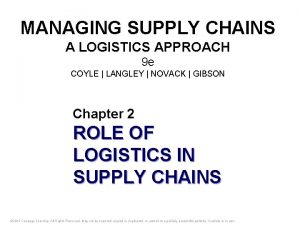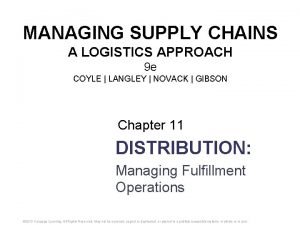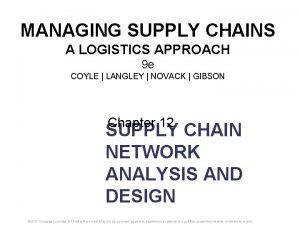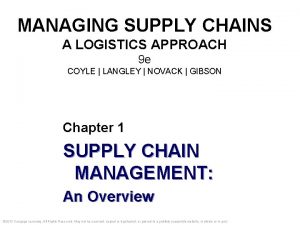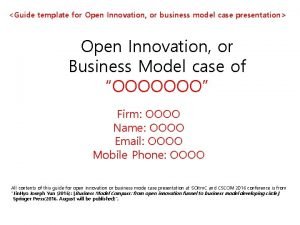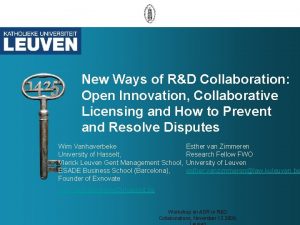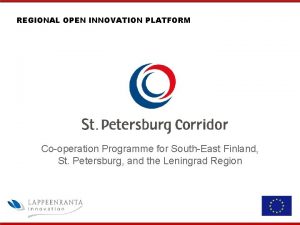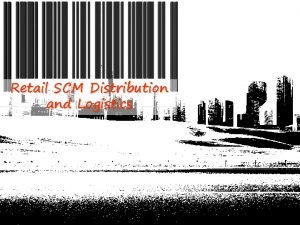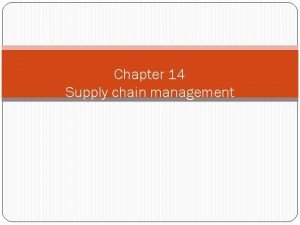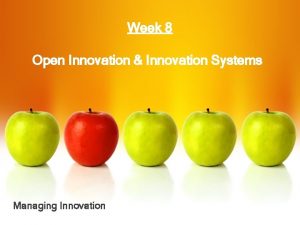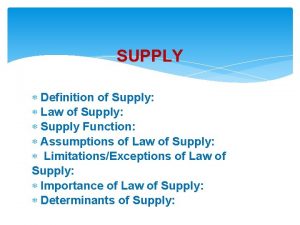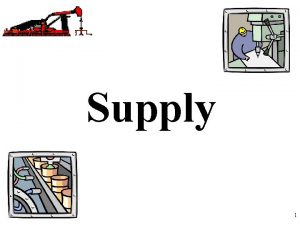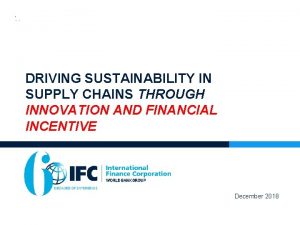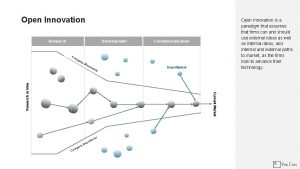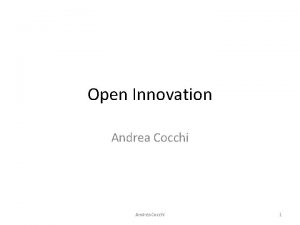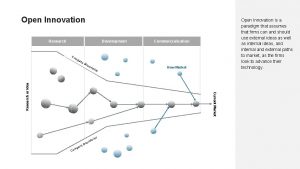Open innovation in supply chains Open supply chains


















![Sources AI, 2013. Open Innovation in additive Industries. [Online] Available at: http: //www. slideshare. Sources AI, 2013. Open Innovation in additive Industries. [Online] Available at: http: //www. slideshare.](https://slidetodoc.com/presentation_image/5bbd03fe56647e86bbd3dc7a75c6c11d/image-19.jpg)

- Slides: 20

Open innovation in supply chains; Open supply chains Supporting Innovation Education Reloaded: Nurturing Skills for the Future. The Open Innovation Teaching Handbook teaching slides proposed by Kristina Zgodanova Christos S. Tsanos Klas Eric Soderquist Co-funded by the European Union Ref. number: 542203 -LLP-1 -2013 -1 -FI-ERASMUS-ENW

Learning Objectives Knowledge o o #2: To explore concepts of collaborative innovation and apply them #17: To learn to recognize source of innovation and operationalization of these sources. #38: To identify the nature and characteristics of the innovation process. #69: To identify external sources of innovation Skills o o #41: To critically analyse case studies related to innovation. #42: To analyse innovation needs of a company Competences o o o #1: To recognize, design and analyse innovative business models. #43: To emphasize the strategic perspective of innovation management #46: To recognize and exploit aspects related to open innovation

Learning Objectives Objective of the lecture o Lecture targets MSc students in engineering and management and MBAs in management, and aims at providing them with profound understanding of open innovation concepts and strategies in the context of supply chains. Workload o 4 -6 teaching hours; 8 h self-study Learning outcomes o o Understanding the evolving role of suppliers as partners in and contributors to innovation and new product development. Understanding how OI contributed and contributes to transforming industrial models in the global manufacturing industry, and how the supply chain is managed in order to leverage innovation.

Lecture Content Definitions The Origins of Supplier-Driven Innovation From Lean Supply to Open Innovation in the Supply Chain Supply chain evolution perspective Early supplier involvement and involvement in different life-cycle stages Inter-organisational supply chain relationships and collaborative innovation o Practical implications o o o

Definitions o Supply chain – The network created amongst different companies producing, handling and/or distributing a specific product. Specifically, the supply chain encompasses the steps it takes to get a good or service from the supplier to the customer. o Closed Supply Chain (CSCH) – Is a highly integrated set of networks in which many of the technologies being applied are developed at least partially by the company orchestrating the system. o Open Supply Chain (OSCH) – The emphasis is on standardised components that fit together in a modular fashion. In these systems, suppliers are generally encouraged to be the main innovators and sell the same components to a range of customers. OSCH is common in industries such as automotive, aerospace and many areas of consumer electronics. Source: Marsh, 2011

Definitions o Open Innovation (related to supply chain) – The focus is on knowledge flows between suppliers and their customers, and between complementary or collaborating suppliers in the same tier, or across tiers in a given supply chain, with the objective of enhancing innovation in the final output. The focus is also on developing and implementing those pecuniary and non-pecuniary mechanisms that will ensure appropriate coordination, collaboration and integration in the supply chain so that the intended innovation outcomes can be reached. o Networked Innovation (related to supply chain) – It occurs "through relationships that are negotiated in an ongoing communicative process, and which relies on neither market nor hierarchical mechanism of control" (Swan & Scarborough, 2005). It is a hybrid form of organisation with a specific purpose for collaboration and multiple actors involved in the innovation process. The collaboration covers both knowledge transfer and co-creation activities between actors (Valkokari et al. , 2009). Source: Valkokari, et al. , 2009

The Origins of Supplier-Driven Innovation o The widespread focus on the supply chain and on suppliers as a source of innovation has its roots in the introduction, diffusion and implementation of lean production, which, inspired by Japanese practices, was implemented across Western manufacturing industry during the 1990 s. o Lean production as an integrated industrial model involving design, manufacturing supply chain and customer relations, presents lower inventory levels, uncovers and solves quicker and more systematically quality problems, assure continuous flow production and makes utility workers unnecessary, compared to traditional 'buffered' mass production systems. Source: different sources

The Origins of Supplier-Driven Innovation o Lean drives changes in supplier relations and in SCM, in particular the implementation of the pyramidal tier-structured supply chain structure. It brings a reduced number of direct suppliers for the OEMs, increased innovation and product development responsibility for the remaining suppliers, and tight coordination based on trust o Direct and indirect supply concern both supply of physical components and of development intelligence leveraging innovation. This can be illustrated in a typology of suppliers with four distinctive roles based on the relationship types (Direct supplier; Indirect/direct supplier Indirect influential supplier). Sources: Soderquist, 1997; Lamming, 1993

From Lean Supply to Open Innovation in the Supply Chain o o Increasingly open supply chains are a natural evolution of lean production and lean supply. The evolution of supply chains with an increasingly open and supplier-driven approach to innovation can be summarized in three phases: Adapted from: Al, 2013

From Lean Supply to Open Innovation in the Supply Chain o The main driver and explanatory factor of the supply chain evolution is the relation to innovation in the supply chain, which has evolved along the types of open innovation: The Internal model relying on inside-out innovation, the Open model relying on inside-out innovation, and the Networked model relying on coupled innovation of equal contributors. o The networked innovation model emphasising both more upstream research and concrete project-based new product development, is becoming the norm in technology- and innovation –driven businesses. A major facilitator of the networked model is the pre-competitive standard of 'plug and play' interfaces allowing innovators to focus on core technologies and instead of on solving interface problems Source: different sources

Supply chain evolution perspective o Analysing in depth the supply chain evolution perspective, Blankendaal (2016) illustrates an open supply chain system in the context of the flow logic of a product development process, e. g. , the stage-gate or funnel logic. Source: Blankendaal, 2016

Supply chain evolution perspective o Suppliers of different tier levels contribute to innovation by engaging in the central activities of product development, from design and engineering to system integration. This means that they also contribute to and are part of the management of all the horizontal activities transcending the development steps. o In order to capture supplier-enabled and supplier-driven innovation, the procurement functions in all buying companies in an open supply chain need to strategize around and manage: Recognition as a customer of choice; process integration of both innovation and procurement activities; internal stakeholder alignment; supplier connectivity mechanisms; and technological enablers for delivering supplier innovations. o The case study of Electrolux (see OI-NET case repository) describes the process used to capture innovation possibilities outside Electrolux and shows an example of supplier-enabled innovation. Source: Short, 2015

Early supplier involvement and involvement in different life-cycle stages o Early supplier involvement (ESI) is a way of institutionalizing an open approach to innovation. o ESI leverages the advantages of supplier involvement and formalizes the process of working with suppliers in innovation and new product development. o ESI affects the management of buyer-supplier relationships in design, procurement and manufacturing. o ESI needs a basic framework for early and substantial supplier involvement including means of communication, motivation, supplier selection process, securing of propretarity information and clear goal setting. o Supplier involvement concerns all stages of the product lifecycle from the earliest, when suppliers may provide design suggestions or even be given complete responsibility for the design, engineering and development of the new product, to later stages, when suppliers may help commercialise the product and manage after-sales product quality. o In the context of Open Innovation, supplier involvement in the product lifecycle is complemented by the involvement of end customers. Source: different sources

Inter-organisational supply chain relationships and collaborative innovation o The relationship between collaborative supply chain relationships and open innovation is mediated by the degree of integration across the supply chain. Weak integration hampers supply chain performance in general and supplier-driven innovation in particular. o The formation of collaborative relationships is facilitated by factors such as: Ø Ø Ø Trust between supply chain partners; Relationship commitment; Mutuality and reciprocity of benefits stemming from the relational exchange. o These factors lead to relationships that can achieve a higher degree of integration across the supply chain. Source: different sources

Inter-organisational supply chain relationships and collaborative innovation o The case study of Faurecia – automotive equipment supplier (see OI-NET case repository) describes the Open innovation process which is used to bring highly innovative concepts to market. Each x. Works center closely researches its regional market, collaborating with various ecosystems that present different opportunities for development of automotive seating in regions. o Beyond industrial and business partnerships in supply chains, recently developed stakeholder engagement concepts such as 'Open Innovation 2. 0' and the 'Quintuple Helix' model also emphasize government, academia, civil society and the natural environments of society and the economy as drivers for innovation and co-creators of the future. Source: different sources

Practical implications o The issue of Open Innovation in the supply chain is essentially applied and practical. o To sum up on the practical implications, three issues are of particular importance: 1) 2) 3) In nearly every sector, many of the ideas and technologies that generate products emerge from a number of participants in the value chain (Bughin et al. , 2008). Innovations have previously been associated mostly with the application of new technologies to products and services, which was closely linked to their commercialisation according to existing business models. Open Innovation means to access new technology, deliver process improvements and create added value by tapping into capabilities of a broad range of partners, including suppliers and customers. Thus, OI drives the development of new business models. As Open Innovation spreads in supply chains, the importance of supplier-driven innovation increases leading to new demands being raised on procurement and supply chain management. Source: different sources

Practical implications Mini cases: o o Old Wine in New Bottles? Mercedes-Benz – Teldix - Bosch Mini Case on the development of ABS Braking Systems Developing New Innovation Capabilities: Expert Suppliers Broadening their Innovation Capabilities Content related material – case studies: o o Faurecia – Open Innovation in Supply Chain. http: //www. oi-net. eu/m-surveys/m-repositorywp 3 -list/details/7/568/repository-oi-cases-faurecia-%20 -open%20 -innovation%20 -insupply%20 -chain Eletrolux: Supplier enabled innovation along with Open Innovation. http: //www. oi-net. eu/msurveys/m-repository-wp 3 -list/details/7/582/repository-oi-cases-supplier%20 -enabled%20 innovation%20 -along-with%20 -open%20 -innovation%20 -in%20 -electrolux? start=20 Source: different sources

Practical implications Harvard Business School Cases o o o o Numico (A): Delivering Innovation trhough the Supply Chain , 2005. Carlos Cordon; Thomas E. Vollmann; Luis Vivanco. Numico (B): Transforming the Supply Chain to Support New Realities, 2005. Carlos Cordon; Thomas E. Vollmann; Luis Vivanco Three-Dimensional (3 D) Printing: Jolts on Supply Chain Management and the Chinese Manufacturing Industry, 2016. Benjamin Yen; Yihong Yao. Quirky: A Business Based on Making Invention Accessible , 2013. David Hoyt; Michael Marks. Am. Tran Technology Ltd, 2015. Willy Shih; Jyun-Cheng Wang; Karen Robinson Apple Inc. : Managing a Global Supply Chain , 2014. Fraser P. Johnson; Ken Mark Munoz Group: Sustaining Global Vertical Integration Through Innovation , 2015. Jose B. Alvarez; Annelena Lobb. Other cases o o o Jiao, Y. -Y. , Du, J. , Jiao, R. & Butler, D. , 2008. Operational implications of early supplier involvement in semiconductor manufacturing firms: A case study. Journal of Manufacturing Technology Management, 19(8), pp. 913 - 932. Brainport Industries case study: From managing supply towards managing innovationhttp: //www. agoria. be/upload/agoriav 3/waardecretie%20 John%20 Blankendaal. pdf Tesla Motors: A case study in disruptive innovation: http: //blog. ihs. com/q 14 -tesla-motors-a-case-study-indisruptive-innovation
![Sources AI 2013 Open Innovation in additive Industries Online Available at http www slideshare Sources AI, 2013. Open Innovation in additive Industries. [Online] Available at: http: //www. slideshare.](https://slidetodoc.com/presentation_image/5bbd03fe56647e86bbd3dc7a75c6c11d/image-19.jpg)
Sources AI, 2013. Open Innovation in additive Industries. [Online] Available at: http: //www. slideshare. net/dajkersten/130226 -open-innovation-in-additive-manufacturing-v 3 Accessed 21 January 2016]. Marsh, P. , 2011. Closed encounters with suppliers. [Online] Available at: http: //www. ft. com/cms/s/0/ce 1 be 8 bc-a 804 -11 e 0 -afc 2 -00144 feabdc 0. html#axzz 3 wqb. UWS 8 p [Accessed 5 January 2016]. Valkokari, K. , Paasi, J. , Lee, N. & Luoma, T. , 2009. Beyond Open innovation - the concept of networked innovation. New York City, USA, s. n. Soderquist, K. , 1997. Inside the tier model: Product development organization and strategies in automotive supplier firms. Unpublished doctoral thesis. , s. l. : Brinel University, Henley management College and Groupe ESC Grenoble. Lamming, R. , 1993. Beyond Partnership, Strategies for Innovation and Lean Supply. Hertfordshire : Prentice Hall International. Blankendaal, J. , 2016. Brainport Industries: Towards the smartest supply chain. [Online] Available at: http: //www. agoria. be/upload/agoriav 3/waardecreatie%20 John%20 Blankendaal. pdf [Accessed 3 March 2016]. Bughin, J. , Chui, M. & Johnson, B. , 2008. The next step in open innovation. [Online] Available at: http: //www. mckinsey. com/insights/operations/the_next_step_in_open_innovation [Accessed 10 January 2016]. 19

Thank you! The slides are licensed under a Creative Commons Attribution-Share. Alike 4. 0 Unported License. Visit www. oi-net. eu to learn more about the project and download the free book Innovation Education Reloaded: Nurturing Skills for the Future. The Open Innovation Teaching Handbook This project has been funded with support from the European Commission. This publication reflects the views only of the author, and the Commission cannot be held responsible for any use which may be made of the information contained therein. 20 Programme: ERASMUS # 542203 -LLP-1 -2013 -1 -FI-ERASMUS-ENW
 영국 beis
영국 beis Besigheidsplan
Besigheidsplan Radical innovation vs disruptive innovation
Radical innovation vs disruptive innovation Managing supply chains a logistics approach
Managing supply chains a logistics approach Managing supply chains: a logistics approach
Managing supply chains: a logistics approach Managing supply chains a logistics approach
Managing supply chains a logistics approach Managing supply chains a logistics approach
Managing supply chains a logistics approach An integrated model for the design of agile supply chains
An integrated model for the design of agile supply chains Open innovation canvas
Open innovation canvas Open innovation platform tsmc
Open innovation platform tsmc Open innovation collaborative
Open innovation collaborative Open innovation platform
Open innovation platform Chapter 5 section 1 supply and the law of supply
Chapter 5 section 1 supply and the law of supply Ang elastisidad ng supply ay
Ang elastisidad ng supply ay Matching supply and demand in supply chain
Matching supply and demand in supply chain Founder of organic chemistry
Founder of organic chemistry Food webs of the rainforest
Food webs of the rainforest Scm retail management
Scm retail management Food chains start with what
Food chains start with what Web
Web Food webs clipart
Food webs clipart



